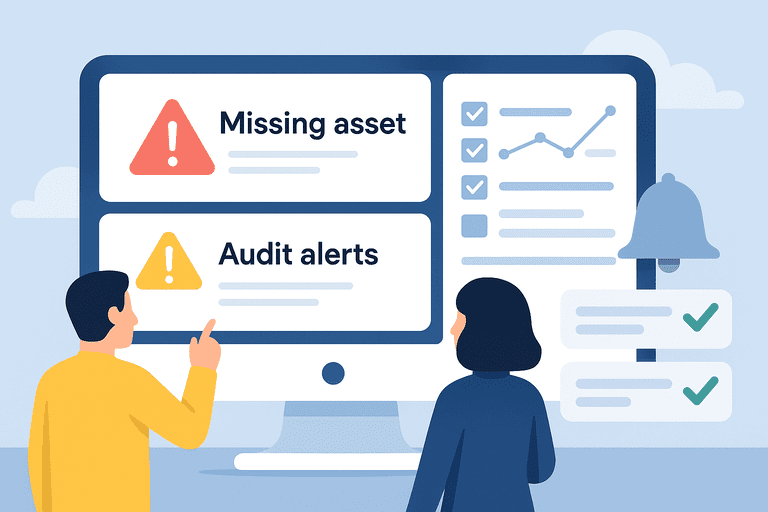Automating Audit Alerts: How to Catch Discrepancies Early
Learn how automated audit alerts detect inventory discrepancies early—improving accuracy, compliance, and operational efficiency across your asset tracking system.

Introduction
Even with well-managed inventory systems, discrepancies happen—items misplaced, status changes missed, or assets not updated after maintenance. Traditionally, these issues are caught only during periodic audits, often months too late.
Automated audit alerts change that. By continuously monitoring asset data, these systems can identify irregularities in real time—long before they turn into costly problems.
This article explores how audit automation works, what triggers matter, and how to integrate early-warning systems into your inventory management workflow.
1. Why Early Detection Matters
Small discrepancies often signal larger systemic issues:
- Missing or duplicated asset IDs
- Outdated location data
- Items not returned after checkout
- Equipment listed but never scanned
The longer they go unnoticed, the harder it becomes to fix them.
Early detection helps to:
- Maintain data integrity
- Prevent financial misstatements
- Support compliance and internal audits
- Reduce manual reconciliation time
A single missing laptop might seem minor—until your annual audit uncovers dozens with no clear ownership trail.
2. The Role of Automation in Modern Auditing
Manual auditing depends on human review cycles. Automation adds a real-time layer of control.
Automated audit systems continuously compare current data against defined rules.
When discrepancies appear, alerts are triggered for review.
Example triggers:
- Asset assigned to two users simultaneously
- Device location changed without an update
- Expired calibration dates
- Depreciation schedule misaligned with category policy
- Unscanned assets beyond threshold days
Instead of discovering errors during audits, the system proactively flags anomalies.
3. Setting Up Audit Alerts: Key Components
1. Define Audit Rules
Rules are conditions the system monitors continuously.
Examples include:
- “Asset marked active but last scanned >90 days ago.”
- “Asset location changed without user transfer log.”
- “Calibration due within 7 days.”
Start with a small set of critical alerts and expand over time.
2. Establish Thresholds
Determine what counts as a deviation:
- Time-based thresholds (e.g., inactivity >60 days)
- Location mismatches (asset scanned in unexpected area)
- Quantity differences (booked vs actual count)
3. Integrate Data Sources
Pull consistent data from:
- Asset register
- Check-in/out logs
- Maintenance schedules
- Purchase orders and depreciation tables
Cross-referencing multiple data streams ensures alerts are accurate rather than noisy.
4. Configure Notification Channels
Alerts should reach the right people:
- Email summaries for managers
- Instant notifications in tools like Slack or Teams
- Dashboard widgets for auditors or admins
4. Common Audit Alert Types
| Alert Type | Description | Frequency | Example |
|---|---|---|---|
| Missing Asset Alert | Flags assets not verified in last scan | Daily | “Monitor 42 not scanned in 60 days” |
| Location Mismatch | Detects unexpected physical movement | Real-time | “Asset 312 scanned in a different building” |
| Condition Alert | Notifies when damage or repair reported | On update | “Laptop 21 marked ‘damaged’ twice in one week” |
| Compliance Alert | Checks calibration, license, or warranty expirations | Weekly | “Tool 158 calibration expired 3 days ago” |
| Depreciation Exception | Finds assets with inconsistent depreciation rate | Monthly | “Vehicle 19 uses incorrect depreciation policy” |
Well-designed alerts balance frequency and priority—too many notifications create fatigue, too few create blind spots.
5. Avoiding “Alert Overload”
Automation only helps if people respond to it.
Too many irrelevant alerts lead to desensitization, making teams ignore important ones.
Best practices:
- Start small — focus on 3–5 key triggers first.
- Classify alerts by severity (critical, moderate, informational).
- Review unresolved alerts regularly.
- Fine-tune rules monthly to reduce false positives.
The goal is relevance, not volume.
6. Integrating Alerts into the Audit Workflow
To maximize effectiveness:
- Link alerts directly to audit reports.
- Create audit dashboards summarizing open issues.
- Use “acknowledge & resolve” workflows to track progress.
- Record how long each discrepancy remains open.
This creates an audit-ready trail—showing not just what was found, but how and when it was resolved.
Automation should complement, not replace, human judgment.
Auditors still verify anomalies, but automation ensures they focus only on genuine risks.
7. Benefits of Proactive Audit Automation
Implementing an automated alert system leads to:
- Higher audit accuracy — continuous verification instead of snapshots
- Shorter audit cycles — fewer manual reconciliations
- Improved accountability — every alert has an owner and timestamp
- Faster response times — discrepancies fixed within days, not months
Organizations that maintain real-time audit health data also perform better in external compliance checks, since historical alert logs demonstrate consistent oversight.
Conclusion
Audit automation turns inventory control into a living process rather than a once-a-year event.
By defining smart rules, setting realistic thresholds, and monitoring key indicators, you can detect discrepancies early—before they affect compliance or financial accuracy.
An automated alert system doesn’t just find errors; it builds a culture of continuous improvement and accountability.
Want to improve your audit accuracy and reduce manual work?
Continue with these guides: